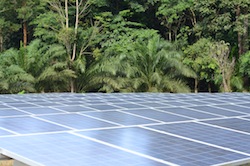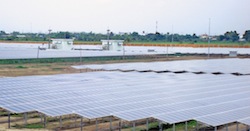Bioenergy company Amyris, Inc. and GOL Linhas Aéreas Inteligentes S.A. (GOL) the largest low-cost and low-fare airline in Latin America, have announced the signing of a memorandum of understanding (MOU) that will pave the way for GOL commercial flights to use Amyris renewable jet fuel in 2014. The partnership was announced during the first commercial flight with a renewable jet fuel in Brazil by the airline.
“GOL is committed to making commercial aviation more efficient and sustainable. Our  experimental flight with renewable jet fuel at the Rio+20 in 2012 was an important step to guide our work. Today, we advance one more step,” said Adalberto Bogsan, Vice President of GOL.
experimental flight with renewable jet fuel at the Rio+20 in 2012 was an important step to guide our work. Today, we advance one more step,” said Adalberto Bogsan, Vice President of GOL.
Under the MOU, GOL and Amyris will work together to establish a framework for bringing Amyris renewable jet fuel produced from Brazilian sugarcane to GOL’s commercial flights. However, for thid to happen, regulatory approvals and validation by standard-setting bodies, including ASTM International and Brazil’s Oil, Gas and Biofuels Agency (ANP) will need to occur.
The partnership, under of auspices of the Brazilian Biofuels Platform, an industry and government-supported initiative to encourage the use of renewable fuels in aviation, was announced at Brazilian Aviation Day celebration, which included participation of Brazil’s Secretary of Civil Aviation, Minister Moreira Franco, and a number of industry stakeholders including Brazilian Airlines Association (ABEAR), Brazilian Biodiesel and Biojet Association (UBRABIO), GE, and Boeing among others.
“GOL supports all initiatives to help make Brazilian aviation more sustainable,” says Paulo Kakinoff, President of GOL. During this past year, the airline’s fuel saving initiatives have helped it to reduce greenhouse gas emissions by over 30 thousand tons.
Lifecycle analysis indicates that the Amyris renewable jet fuel could reduce greenhouse gas emissions by 80% or more when compared to convention fossil-derived jet fuel. Amyris has applied for certification under the Roundtable of Sustainable Biomaterials (RSB) and is a member of Bonsucro, the world’s leading sugarcane sustainability standard.
“We are committed to working with the aviation industry to bring cleaner skies, starting in Brazil in 2014. Following two successful demonstration flights and a series of successful tests with multiple industry stakeholders, we look forward to receiving ASTM validation and ANP approval of our breakthrough renewable jet fuel produced from Brazilian sugarcane,” said John Melo, Amyris’s President & CEO.
 New numbers from the Environmental Protection Agency (EPA) show that biodiesel has once again broken the 1-billion-gallon mark. Biodiesel production hit 140 million gallons in September, pushing the year-to-date biodiesel total of nearly 1.1 billion gallons, the third year it has reached that milestone. The news was welcomed by the National Biodiesel Board:
New numbers from the Environmental Protection Agency (EPA) show that biodiesel has once again broken the 1-billion-gallon mark. Biodiesel production hit 140 million gallons in September, pushing the year-to-date biodiesel total of nearly 1.1 billion gallons, the third year it has reached that milestone. The news was welcomed by the National Biodiesel Board:









